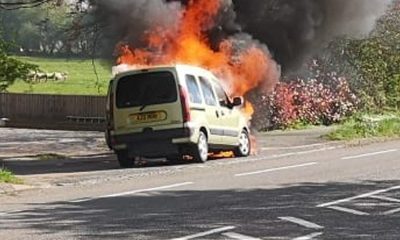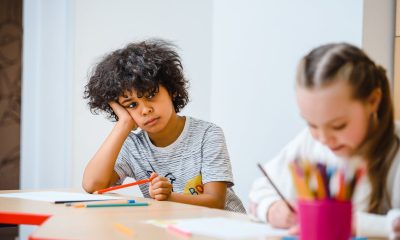Creature from 120 million years ago was bird/dinosaur combo
It was among the earliest examples of dinosaurs evolving into birds.
Published
1 year ago onBy
Talker News
By Mark Waghorn via SWNS
A bizarre creature that lived 120 million years ago was a bird/dinosaur mix, according to new research.
Jeholornis had blue, brown and grey feathers, a long tail and small teeth - inherited from its reptile ancestors.
Scientists have reconstructed its skull for the first time - revealing a brain made for smelling and eyes for daylight.
Co-author Professor Matteo Fabbri, of the Field Museum, Chicago, said: "The morphology is transitional, in between what we see in non-avian dinosaurs and what we see in modern birds.
"If you look at the skulls of dinosaurs, what you see is a spot for a very reptile-like brain, meaning they have very large olfactory bulbs, and the optic lobes in the midbrain are reduced.
"They probably had a very good sense of smell and not great sight, which is very reptilian.

"And on the other hand, if you look at modern birds, they do the reverse. They have small olfactory bulbs, and very large optic lobes. Jeholornis falls in the middle."
Raven-sized Jeholornis is the earliest known animal to eat fruit. The international team selected the best specimen unearthed from prehistoric graveyards in China.
It was finely preserved and intact but a little flattened by layers of sediment deposited across the ages.
First author Dr. Han Hu, of the University of Oxford, said: "It is very difficult to find the right skull among around 100 fossils since we won't know if one skull will provide us the information we want before the scanning.
"Due to the costs of high-quality scanning, we couldn't scan all those specimens to choose the best one.

"However, I chose this one because at least from the exposed surface, it is relatively complete. What is also important is this skull is isolated from other parts of its body.
"This is very helpful since we usually won't chop the skull off from the skeleton if they are articulated.
"No one wants to hurt these previous fossils, but an isolated skull will reduce the size of the scanning area, which will increase the scanning quality a lot.
"Luckily, the specimen we chose here for this project is nearly a perfect one - it provided us with so much unknown information after the digital reconstruction."
The study provides the first accurate depiction of Jeholornis - showing it was among the earliest examples of dinosaurs evolving into birds.
Co-author Prof Jingmai O'Connor, also from the Field Museum, said: "Jeholornis is my favorite Cretaceous bird.
"It has a lot of unusual, primitive traits, and helps shed light on the bigger story of how different birds evolved.
"This study is the first time we are really getting at what this bird's skull looked like, what its brain must have been like, which is really exciting."
With remains smashed flat, no one has been able to get a good look at Jeholornis - until now.
Explained Prof O'Connor: "These bones were kind of like the bottom of a bag of potato chips - they weren't completely crushed, but the pieces were compacted.

"So we were able to CT scan them - essentially taking a bunch of X-rays and stacking them together to form a 3D image - and then digitally re-articulate them and reconstruct the skull from all these bones."
Knowing the shape and dimensions of a fossil bird's skull tells us a lot about its brain - like how a glove gives a decent approximation of a hand.
What's more, brain structures are conserved across species over time. Olfactory bulbs and the cerebellum are in the same general spots in a frog, a human or a fossil bird.
Dr. Fabbri said: "We were able to see different features of the skull that had never been seen before in Jeholornis, and we were even able to extrapolate what its brain looked like."
It enabled comparisons. Jeholornis had bigger olfactory bulbs than most modern birds, meaning it probably relied more on smell with a few exceptions such as vultures.
Prof O'Connor said: "As fruits ripen, they release lots of chemicals. Having a better sense of smell might have helped Jeholornis find fruit."
Birds have bones called scleral rings that help determine how much light goes into their eyes.
Nocturnal species like owls have wider openings relative to their eye sockets. Birds active during the day have narrower ones, like Jeholornis.
The skull features described in Zoological Journal of the Linnean Society shed fresh light on the primitive bird's lifestyle and place in the ecosystem.
Dr. Fabbri said: "Reconstructing a skull is painstaking work, and as people are starting to put in the time to do it, it is becoming more and more clear the evolution of birds was more complicated than what we expected.
"It is not just different from dinosaurs and modern birds, it is different from other early birds too. It is not a straightforward evolutionary story."
So when we look out the window at our feathered friends, we are actually watching dinosaurs.
Dr. Hu added: "The same as Jingmai, Jeholornis is also one of my favorite birds.
"Its special position as one of the most primitive birds during the dinosaur-bird transition determines completing its story will reveal the true scenery of that critical evolutionary period, and also, tell us why and how the modern birds - the only living dinosaurs - evolved to be what we see now."
Stories and infographics by ‘Talker Research’ are available to download & ready to use. Stories and videos by ‘Talker News’ are managed by SWNS. To license content for editorial or commercial use and to see the full scope of SWNS content, please email [email protected] or submit an inquiry via our contact form.
You may like


Metals can heal themselves just like ‘The Terminator’


Two-faced star has hydrogen on one side and helium on other


World’s oldest big game hunting weapon found


An espresso a day could keep Alzheimer’s at bay


Being bipolar significantly raises risk of premature death: study


Soccer players who regularly use head more likely to develop Alzheimer’s
Other Stories


One-year-old can’t stop laughing during first ride at Disneyland
"We didn't expect him to love it that much."


Dad running marathon wearing chainmail weighing over 40 pounds
A dad is attempting to break the world record for the fastest marathon while wearing chainmail.


Hero saves elderly couple by dragging them out of burning car
The Good Samaritan jumped into action after spotting the fire on his way to work.


Bomb squad seals off town after ammunition shell donated to charity shop
Staff discovered the device in a bag of donations.


Woman recovers stolen phone after chasing down thief
She was not going to let the thief get away.
Top Talkers

 Parenting1 day ago
Parenting1 day agoSingle mom details struggles of feeding her 12 kids

 Broadcast3 days ago
Broadcast3 days agoOver 40% of Americans have no clue what a 401k is

 Broadcast1 week ago
Broadcast1 week agoGrocery shopping hungry is costing Americans this much

 Funny1 week ago
Funny1 week agoCops confused by crow mimicking police siren

 Broadcast2 days ago
Broadcast2 days agoHow hard is it for Americans to live sustainably?

 Shopping1 week ago
Shopping1 week agoGrocery shopping hungry costs Americans this much every trip

 Money3 days ago
Money3 days agoOver 40% of Americans have no clue what a 401k is

 Parenting7 days ago
Parenting7 days agoIt takes this many minutes for the average American kid to get bored
